PART FOUR
RETIREMENT AND MORTALITY
Eleven
The Impact of Aging on the Employment of Men in American Working-Class Communities at the End of the Nineteenth Century
Roger L. Ransom and Richard Sutch
At the end of the nineteenth century, one out of every three males in the U.S. labor force relied on a wage-earning job as their principal source of economic support and long-term security.[1] For working-class families in the cities, this dependence on wage employment posed a growing challenge as the head of the household grew older. The older worker found it increasingly difficult to support himself and his immediate family from wage income. Perhaps the most important factor contributing to this problem is the tendency with advancing age for health and physical ability to decline. As a consequence, the economic productivity of the worker declined and his daily wage fell after he passed "middle age." In the absence of formal arrangements to offset the effects of this decline in productivity, workers were obliged to look for alternative arrangements to maintain their purchasing power as they became older.
The prospect of declining productivity—with its concomitant decrease in wage earnings—was a bleak one for the fraction of the population who knew no other occupation than industrial wage labor. So long as the industrial wage system paid employees their current marginal product, employers had no incentive to terminate the employment of older workers with the firm, and the reduced wage offered by employers could be expected to reduce the supply of labor forthcoming. However, if wages tended to be sticky, then older workers would be increasingly overpaid, and this would give the employer an incentive to discharge the worker or at least to minimize the number of days the older worker would be employed. Either way, the incomes of older workers would be reduced.
All of this was not lost on workers, who clearly recognized that their economic situation would ultimately deteriorate. Workers anticipated the problem and tried to accumulate assets during their peak earning years to draw
upon later. They also sought to make new arrangements with their employer to ensure greater job security. In this way, labor markets gradually evolved long-term (often implicit) contracts that underpaid younger workers, overpaid older workers, provided security of employment, and set a predetermined age for retirement. Yet we know surprisingly little about how these arrangements, which offer a considerable degree of economic security for older workers today, emerged in the United States over the past century.
In this chapter, we look to the period just prior to the turn of the century, before many of the features taken for granted today had evolved. We use census data and a series of surveys of working-class households taken in the 1890s by state bureaus of labor statistics to examine the situation of older workers. Our attention is drawn to four general aspects of labor arrangements at that time.
1. The phenomenon of voluntary retirement from the industrial labor force was already firmly in place by 1900. By that time workers were aware of the threat of dependency in old age, and many had accumulated sufficient assets to quit work at ages ranging from 55 to 65.
2. Not all workers were able to retire. Our survey data provide considerable support for the hypothesis that many older workers moved to less demanding jobs as they aged. In an earlier study we termed this phenomenon downward occupational mobility (Ransom and Sutch 1986a ).
3. There seems little doubt that this life cycle deskilling of workers is mirrored in the returns to labor. One of the most striking features of the labor markets to emerge from our examination of the data is a hump-shaped profile of income and earnings that shows up across a wide variety of locations.
4. The decline in earnings was not only a result of lower daily wages. An examination of the days lost to various causes clearly suggests that older workers also experienced a different pattern of employment and that this pattern was related to both sickness and involuntary unemployment, on the one hand, and a greater consumption of free time, on the other.
Retirement at the End of the Nineteenth Century
The propensity of older American men to retire from the labor force after the age of 60 is well documented and well studied for the period following World War II. Until recently, however, information on the period before 1940 was sketchy. In the absence of statistical data, the common belief shared by economists and historians was that retirement was virtually unknown at the beginning of the twentieth century, made its appearance shortly after 1900, and then gradually increased in the years
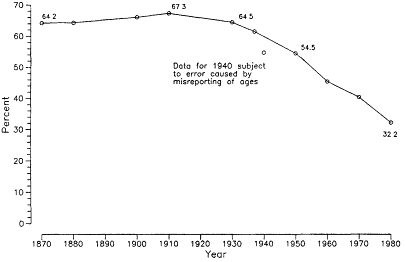
Fig. 11.1.
Labor force participation, males aged 60 and over, 1870-1980.
leading up to 1940.[2] We challenged this view, compiling new evidence on labor force participation for the period from 1870 to 1940 which suggests that retirement was common throughout the entire period and that retirement rates were stable before they began a marked increase in the late 1930s.[3]
Figure 11.1 summarizes our present view of the trend in labor force participation for men 60 and over for this period. Retirement was not unusual at the turn of the century; in 1900, the probability of eventual retirement for a 32-year-old man was more than 35 percent. Indeed, national retirement rates for males were about the same in 1870 (35.8 percent) as they were in 1930 (35.5 percent). The propensity to retire began a remarkable ascendancy sometime in the late 1930s or early 1940s and has continued steadily throughout the postwar period.[4]
An examination of the impact of aging on the employment of men around the turn of the century presents a unique research opportunity to reexamine the causes and role of retirement at a time when social security benefits did not exist and few company pensions were vested in the worker. Retirement in this era was largely financed from savings accumulated while working.[5] The relatively high proportion of older males who remained at jobs in the late-nineteenth-century labor market suggests that the experience of these men was rather different from that of the current generation of retirement-aged men. Here we will explore that experience using as our guide a rich body of data collected at the end of the nineteenth century by
state governments interested in examining the working conditions in the United States.
The Surveys of Working-Class Households
In 1869, the Commonwealth of Massachusetts established the first state bureau of labor statistics in an effort to collect and present statistical data on the conditions of labor to the state legislature. Under the direction of Carroll D. Wright, who became chief in 1873, the Massachusetts bureau pioneered the canvassing of households to collect dam on the occupation, wages, demographic characteristics, and working conditions of "ordinary workers." Wright insisted that all of the data collected had to be made available for these surveys to have scientific respectability and political influence. Accordingly, in the Sixth Annual Report for 1875, the Massachusetts bureau published all of the data from each of the 397 individual responses to a survey taken the previous year.[6] The success of the dam-collecting efforts and the political impact of the published reports prompted other states to follow Massachusetts' lead and create similar agencies dedicated to the collection of survey data on working conditions. These state bureaus conducted numerous surveys of workers in the late 1880s and in the early to mid-1890s, and, following Wright's example, each individual response was published in the Annual Reports .[7]
While the range of issues dealt with by the bureaus varied from state to state, it is clear that economic and social issues prominent at the time that the surveys were taken shaped the questions being asked. Every survey included questions on working conditions that provide data on occupation, hours worked, wage rates, and in many instances, the number of years of tenure with the employer and within the occupation. Most surveys included several questions dealing with immigration (place of birth, place of parents' birth, years in the United States, funds on arrival), union membership, and newspaper subscriptions. Concern over unemployment produced detailed questions into the amount of time "lost" from work and the reasons for lost time. Finally, there was an evident concern about the ability of working-class households to meet their expenses, which led to questions about income, expenses, and ownership of assets such as houses, life insurance, and bank accounts. These economic data are combined with demographic information on the age of the worker and the size of his or her family and the number of dependents.
These surveys, together with the various "special reports" prompted by the depressed conditions in the 1890s, provide an extraordinary window through which economic historians can examine the economic and social situation of workers at the end of the nineteenth century. Yet until very recently, when the advent of microcomputers made it feasible to put these
data into machine-readable form, the rich volume of data contained in these state reports remained largely untapped by researchers.[8] In 1989, we began, in collaboration with Susan Carter, a systematic attempt to create a machine-readable database of macroeconomic data extracted from a selected subset of the more than one hundred separate reports published between 1874 and 1900.[9]
This chapter draws on the responses reported by male workers in ten surveys of working-class households conducted between 1884 and 1896 by the states of Maine, New Jersey, Michigan, Iowa, Kansas, and California. The broad features of the surveys are summarized in table 11.1. Three of the surveys (California, Maine, and Kansas) canvass workers in a large number of occupations and industries across the entire state; the others concentrate on specific industries or occupations within a state. Taken together, these surveys represent a total of 38,776 responses by male workers to questions covering a wide range of topics relating to working conditions.
Our primary focus is on workers in manufacturing. Retirement was primarily an urban nonagricultural phenomenon. Farmers and rural workers in general were less likely to retire, or at least less likely to report themselves without an occupation.[10] However, to provide an occasional comparison, we have also drawn on data from a Michigan canvass of farmworkers taken in 1895.[11]
We should note at the outset several features of these surveys that affect the scope of our analysis. First is the fact that because the bureaus canvassed
TABLE 11.1 | ||||||
Number of Respondents | ||||||
Date | State | Description | Total | Men | Women | |
1890 | Maine | Manufacturing workers in 33 towns | 1,084 | 1,012 | 72 | |
1888-1890 | New Jersey | Workers in 6 industriesa | 12,821 | 12,821 | 0 | |
1888 | Michigan | Stone and clay workersb | 719 | 719 | 0 | |
1889 | Michigan | Furniture industry workers | 5,419 | 5,203 | 216 | |
1893 | Michigan | Railroad employees | 6,051 | 6,051 | 0 | |
1894 | Michigan | Farm laborers | 7,900 | 5,600 | 2,300 | |
1895 | Michigan | Hack and bus line employees | 1,950 | 1,950 | 0 | |
1895 | Michigan | Owners of hacks and drays | 1,250 | 1,250 | 0 | |
1884 | Iowa | Teachers | 347 | 181 | 166 | |
1884-1887 | Kansas | Manufacturing workers in the state | 1,165 | 1,165 | 0 | |
1892 | California | Workers in San Francisco | 3,493c | 2,824 | 634 | |
Total | 42,199 | 38,776 | 3,388 | |||
a Glassmaking, pottery, hat making, and iron mining were covered throughout the state. The building trades and printing were covered in Essex County and the cities of Trenton, Elizabeth, Paterson, and Jersey city. | ||||||
b Fire clay, slate, coal, grindstones, gypsum, and stone. | ||||||
c The gender of 35 respondents was not recorded. These 35 workers were excluded from the analysis. | ||||||
only those workers who are in the labor force, older workers who have left the workforce for any reason will not be included.[12] Also evident from the data of table 11.1 is the absence of female workers from most of these surveys. Except in a few cases (such as the survey of "domestic farmworkers" in Michigan) in which they explicitly targeted female laborers, the bureaus focused their efforts on men. However, the absence of data on female workers should have a relatively small impact on our analysis of older workers, since at this time the female labor force comprised primarily young, unmarried women (Goldin 1990). Finally, any generalizations from these data must also take into account the rather arbitrary collection of cities and towns included in the surveys and must recognize that these are cross-sectional , not longitudinal , data.
Evidence of Downward Occupational Mobility
We begin by examining the age distribution of the workers canvassed in seven surveys mentioned in table 11.1. In all these cases, the intent of those conducting the survey was to obtain a representative sample of workers who fell within the scope of the different investigations. In Maine, Michigan, and California, the questionnaires were administered in person by agents trained for the job. In Kansas and Iowa, questionnaires were distributed through the mail. While little is said about the process by which workers were located and their cooperation secured, we have no reason to believe that a conscious bias for or against including older workers was present. Nevertheless, it is clear that all seven surveys overrepresent workers in their 20s and 30s and have surprisingly few workers over the age of 55. In figure 11.2, the age distributions of respondents are presented as smoothed polynomials in age.[13] The age distribution of all employed men derived from the 1900 census of the U.S. population is shown on the graph to provide a calibration of the distributions from the state surveys.[14]
We offer two explanations for the relative shortage of older workers in these surveys compared to the United States as a whole. First, all the surveys plotted in figure 11.2 concentrated on the nonagricultural population of cities and towns. We believe that retirement rates were likely to be much higher there than in rural districts and on farms. Second, since these surveys concentrated on manufacturing and building trades, we suspect that the age distributions reflect the impact of downward occupational mobility. As workers aged they left (or were fired from) the higher-paying—but also more physically demanding—jobs in these sectors and took lower-paying, lower-status, and less demanding jobs in other sectors. In an earlier article, we called this phenomenon "on-the-job" retirement (Ransom and Sutch 1986a ). We presented evidence from the censuses of 1870, 1880, and 1900 to indicate that this type of age-related deskilling was a common late-nineteenth-century
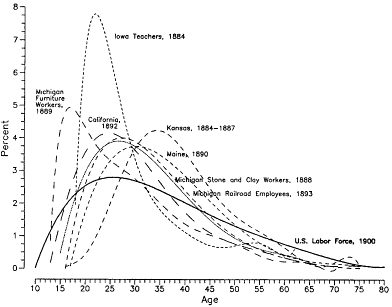
Fig. 11.2.
Age distribution of respondents: Seven state labor surveys and the U.S. census.
phenomenon. Downward occupational mobility is perhaps even more evident in the age distributions from the four industry-specific surveys included in figure 11.2. The surveys of stone and clay workers and furniture industry workers from Michigan and the survey of Iowa teachers all reveal a marked deficit of older male workers relative to the 1900 standard. While the teaching profession may well be a special case, we suggest that the absence of older workers in the two Michigan surveys is largely explained by the departures produced by downward occupational mobility.[15]
Decline of Incomes and Wage Rates with Age
Part of the explanation for the downward occupational mobility revealed by the surveys of industrial workers is suggested by the earnings profiles we have derived from these data. Figure 11.3 presents the income profiles from eight of the data sets. Each distribution shows a hump-shaped pattern, with a tendency for annual incomes to fall markedly at older ages.[16] If this cross-sectional view can be taken as a reflection of the actual or expected experience of a worker as he aged, then the declining returns from industrial employment may well have helped induce an occupational change. There is only very limited longitudinal evidence available to test whether or not we
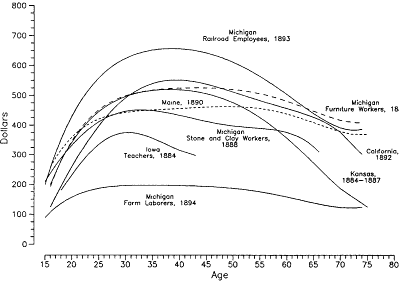
Fig. 11.3.
Age profile of annual earnings: Eight state surveys.
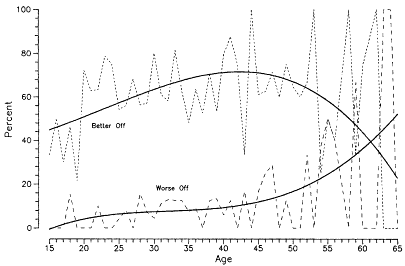
Fig. 11.4.
Perception of current economic well-being relative to five years earlier, Michigan stone and clay workers, 1888.
may safely infer this impact of aging from cross-sectional data. However, two of the surveys, the Michigan stone and clay workers in 1888 and the Michigan survey of railroad employees in 1893, did ask workers whether they were better or worse off (in economic terms) in the year of the survey than they had been five years earlier. The proportion of negative answers for the stonecutters is plotted by age in figure 11.4. After about age 45, the proportion of negative answers rises sharply, suggesting that a substantial fraction of the older workers in this industry had indeed experienced a recent decline in their annual earnings. The proportion of workers reporting no change falls continuously. The data for the Michigan railroad workers, which is a much larger sample published five years later, is presented in figure 11.5. The pattern is similar to that of the stonecutters, although economic conditions had clearly deteriorated.[17] If anything, figure 11.5 suggests that declining income for railroad workers began even before the age of 40, confirming the impression given by the cross-sectional data of figure 11.3.
The decline in earnings as workers aged was produced through the combination of two separate phenomena. First, daily wage rates fell with age after reaching a peak that occurred in some occupations as early as when the workers reached their late 20s. Second, the number of days workers worked for pay during the year fell as workers aged. We first turn our attention to the cross sections of wage rates revealed in our data sets. Figure 11.6 presents the age profiles of daily wage rates reported by the workers in the sep-
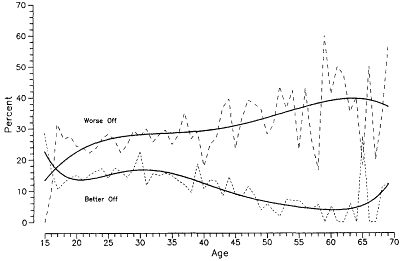
Fig. 11.5.
Perception of current economic well-being relative to
five years earlier, Michigan railroad employees, 1893.
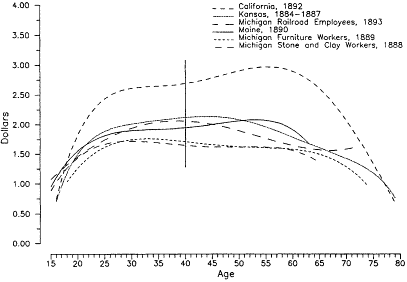
Fig. 11.6.
Age profile of daily wage rates: Six state surveys.
arate surveys. If we assume that these labor markets were largely free from the long-term implicit contracts that characterize modern labor markets, then an obvious reason for older workers to be paid less than younger workers is that their physical productivity was lower. Many of these jobs required physical strength, agility, good eyesight, and other attributes that in many workers would deteriorate with advancing age. Thus, employers were likely either to reduce the daily wage without changing the worker's occupation or to move workers to less demanding but also lower-paid jobs.
The decline in income and wages evident in figures 11.3 and 11.6 could not have been wholly unanticipated by the workers. The demands of industrial jobs were such that most men could foresee the time when they would no longer have the strength, endurance, or agility to maintain the level of productivity consistent with the standard wage. This being the case, some sort of "strategy" had to be devised to meet the challenge of economic insecurity that faces older wage earners.[18]
A novel investigation into the duration of the "trade life" of working men conducted in New Jersey between 1888 and 1890 by that state's Bureau of Statistics of Labor and Industries provides striking evidence that this was so. The investigation was predicated on the assumption that after working at a given occupation for a number of years, the worker would begin to "decline" at his job. To ascertain the effect of occupation on the length of a man's working life, the New Jersey bureau conducted a survey of journeymen asking for their age and occupation, the age they began to work at their pre-
sent trade, and (if they had reached it) the age when they began to decline. All together the bureau surveyed nearly thirteen thousand employed men over the age of 20 in six industries. The surveys were tabulated and the results published in three successive volumes of the bureau's Annual Report (New Jersey 1889, 1890, 1891).
In four industries (glassmaking, pottery, hat making, and iron mining) workers were apparently identified by their employers and were approached by bureau agents who administered the questionnaire. For the building trades and printing, workers were identified in a house-to-house canvass conducted during the early hours of the evening in the county of Essex and in the cities of Trenton, Elizabeth, Paterson, and Jersey City (New Jersey 1891:173). Table 11.2 gives the distribution of those sampled by occupation and estimates the survey coverage. Although tabulations were presented in
TABLE 11.2 | |||||
Occupation | Number Surveyed | 1890 U.S. Census Enumeration | Percentage Coverage | ||
Building tradesa | |||||
Carpenters | 2,732 | 21,191 | 12.9 | ||
Painters | 1,235 | 9,439 | 13.1 | ||
Bricklayers and masons | 1,022 | 6,767 | 15.1 | ||
Plumbers | 661 | 3,085 | 21.4 | ||
Hat makers | 2,577 | 6,137 | 42.0 | ||
Miners of iron oreb | 1,269 | 1,380 | 92.0 | ||
Potters | 1,122 | 3,801 | 29.5 | ||
Glassmakers | 1,040 | 4,298 | 24.2 | ||
Printers | 462 | 3,375 | 13.7 | ||
Total | 12,120 | 61,075 | 19.8 | ||
SOURCES : New Jersey 1891; 178; U.S. Census 1890, vol. 1, pt. II: 324-332, table 79; U.S. Census 1890, vol. 7, Mineral Industries : 17. | |||||
a Stonecutters were also included in the New Jersey investigation (701 were surveyed). However, no data were reported on the age stonecutters began to decline. We assume that for some reason these data were not tabulated. Given the way the reports are presented, an alternative interpretation is that none of the stonecutters had yet begun to decline (New Jersey 1891: 192). Including, rather than excluding, stonecutters would make little difference to the overall results. | |||||
b The 1,269 miners "embrace all the workmen engaged in the mining of iron ore in the State, but do not include engineers, blacksmiths, common laborers, or those employed about the mines in handling the ore" (New Jersey 1890: 359). The U.S. Census of Mineral Industries distinguishes between employees of iron mines "above ground" (492) and those "below ground" (1,380). Only the belowground employees are included in the comparison made here. The census figures are higher than the N.J. Bureau of Statistics enumeration. Possibly this is because the census figures include all workers, while the New Jersey survey included only males aged 21 and over; also, the New Jersey figures probably exclude miners engaged in "prospecting" (New Jersey 1890: 360), while the census figures presumably do not exclude them. | |||||
TABLE 11.3 | ||||
Occupation | Percent Aged 60+ | Percent Beginning to Decline | Average Age of Decline | |
Building trades | 0.8 | 9.5 | 39.8 | |
Hat makers | 2.0 | 14.7 | 36.6 | |
Miners of iron ore | 3.1 | 7.1 | 44.6 | |
Potters | 0.6 | 8.6 | 38.3 | |
Glassmakers | 0.9 | 24.7 | 39.8 | |
Printers | 0.4 | 21.2 | 36.6 | |
Total | 1.4 | 12.0 | 38.9 | |
SOURCES : New Jersey, 1889: 114-115, table 3 summary; New Jersey 1890: 380, table 2; New Jersey 1891: 178; 199-200, table 2; 201, table 3. | ||||
exhaustive detail, no clear summary statement was provided by the New Jersey officials. Two statistics calculated in the reports, the percentage of workers beginning to decline and the average age reported for the onset of decline, are given in table 11.3.
The relatively low percentage of journeymen who were still working at these skilled jobs at age 60 or over suggests that many workers left these occupations before reaching 60. It is not possible from these data alone to determine the reason older workers left their trade. Among the possible causes are retirement (including retirement due to disability or illness), downward occupational mobility, or death.
The percentage of workers who reported that they had begun to decline at their trade is remarkably high. For glassmakers, it was one quarter of all workers. Those who felt they had already begun to decline were asked to report the age at which they first noticed their difficulties. The average response is given in the table. For the entire sample, it was 38.9 years. This measure, however, will be biased downward as a measure of the typical age of peak productivity because it includes only workers who have already begun to decline. Other things equal, a worker prone to an early age of decline will be more likely to have passed this climacteric at the time of the New Jersey canvass than a worker prone to a late decline. As a result there will have been an oversampling of journeymen who began to decline at young ages and an undersampling of the age of decline of the hardy. Another possible objection to the average age of decline reported in the table is that it is based on the recollection of the worker. Such retrospective dating is notoriously inaccurate.
Several measures that eliminate both the type of downward bias mentioned above and the problems associated with the retrospective question are presented as an alternative in table 11.4. All these measures rely on the
TABLE 11.4 | ||||||
Percentage in Decline | ||||||
Occupation | By Age 56 | By Age 60 | By Age 66 | Singulate Mean | Half- Life | |
Carpenters | 33.0 | 51.9 | 70.8 | 56.8 | 59.0 | |
Painters | 54.1 | 67.1 | 80.0 | 50.9 | 53.4 | |
Bricklayers and masons | 37.0 | 49.8 | 62.5 | 55.9 | 59.6 | |
Plumbers | 26.7 | a | a | a | b | |
Printers | 64.3 | a | a | 49.6 | 51.9 | |
Glassmakers | 74.2 | 81.5 | 88.9 | 45.9 | 45.2 | |
Hat makers | 49.2 | a | a | 48.9 | b | |
Miners of iron ore | 48.1 | 61.2 | 74.4 | 55.1 | 55.2 | |
Potters | 77.4 | a | a | 46.7 | 45.2 | |
Unweighted Total | 47.5 | 55.9 | 64.2 | 52.7 | 56.0 | |
NOTE : a indicates that sample size was too small for reliable estimate, b that proportion in decline was less than 50 percent. | ||||||
notion of a synthetic cohort that experiences at each age demographic events at the same rate that workers of that age reported in the cross-section sample. Thus the only information used is the response (yes or no) to the question, "Have you begun to decline at your trade?" The first three columns of the table report the percentage of workers who had already entered their decline by various ages. Column 4 presents the singulate mean age of decline calculated using the synthetic cohort method of John Hajnal (1953). The last column gives the cohort's "half-life," the age at which one-half of the members of the synthetic cohort have begun to decline. Table 11.4 suggests that the typical age for the onset of decline would be in a man's early 50s.
The measures in table 11.4, however, would be unbiased estimates only if the mortality experience of those who began their decline was the same as for those who had not. In this case, "mortality" refers to any reason to cease work, including retirement and job changes as well as death. However, it is quite likely that workers who had begun to decline at their trade were more likely to leave their job than those who had not. The impact of this effect on the synthetic cohort measures will be to bias them upward. Thus we can conjecture that the "true" age of decline lies somewhere between the lower-bound estimates of table 11.3 and the upper-bound estimates of table 11.4. Since the impact of differential mortality will also bias the figures of table 11.3, the truth probably lies closer to the figures in that table where the two biases work to offset each other. The value of the New Jersey data lies not so much in our ability to use it to precisely measure the age at which
industrial productivity peaked for a late-nineteenth-century worker as in the fact that it stands as strong evidence that young workers actually anticipated a decline in their vitality, productivity, and income in late life.
The Number and Causes of Days Worked
We noted at the outset that a major reason for the decline of workers' incomes as they aged was that older men worked and were paid for fewer days each year than their younger counterparts. Figure 11.7 presents the age profile of the number of days worked for the Kansas and Maine surveys, together with the number of months worked in two of the Michigan surveys.[19] Both distributions exhibit a remarkable decline from a peak of over 250 paid days averaged by workers in their 30s to approximately 220 paid days worked by men in their 60s. While the number of months worked by Michigan stone and clay workers and Michigan farm laborers probably reflects seasonal fluctuations due to inclement weather, it is clear that older workers were employed for fewer months than workers in the prime age group.
In several of the surveys the number of days lost is classified by one or more general causes: layoff, illness, and voluntary time off. In figure 11.8 through 11.10, we present some summary statistics on days lost by cause that illustrate the extent to which older workers were compelled by illness or unemployment to work fewer days. Figure 11.8 displays the age profiles for
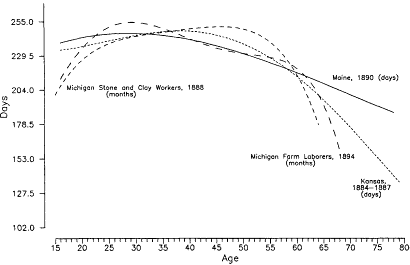
Fig. 11.7.
Age profile of number of days or months worked: Kansas, Maine, and Michigan.
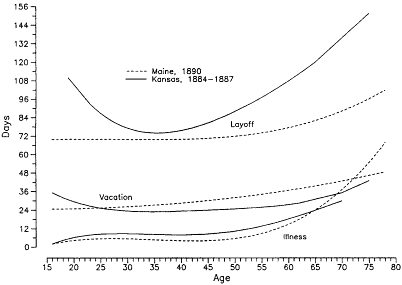
Fig. 11.8.
Age profile of days lost from work, by cause: Kansas and Maine.
days lost in the Maine and Kansas surveys due to illness, lack of work, or vacation. Time lost from all three causes rises with age for both surveys, with the increases in layoff and illness among older workers being particularly pronounced. Figure 11.9 presents the days lost to illness or lack of work by employees of hack and bus lines in Michigan and owner-operators of hacks and drays. While both surveys show a pronounced upward trend with age, it is interesting to note that the self-employed lost more time to illness and lack of work at all ages than did employees. It appears that at least in this industry, self-employment did not provide protection against the problem of lost time. Finally, we note that the effect of illness appears to be as significant among farmworkers as it was for the urban labor force. Figure 11.10 presents the proportion of Michigan farmworkers reporting time lost due to illness according to age.
That illness rises with age is not surprising and reinforces the conclusions we drew from the New Jersey data on physical decline. That employers should single out older workers when layoffs were required is somewhat more surprising given modern labor market institutions that tend to protect older workers with seniority. However, if paternalism or nascent internal labor market institutions tended to prevent wage rates from falling as productivity declined, employers would have had an economic incentive to practice age discrimination when selecting workers for reduced days. It is also possible that employers tended to favor younger men who had young
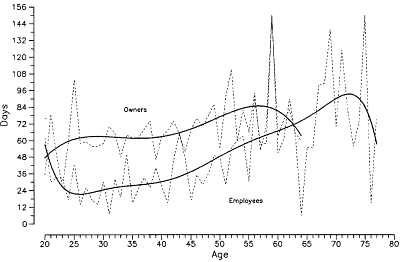
Fig. 11.9.
Age profile of days lost from work due to illness or lack of work,
hack and bus line employees and self-employed owners of hacks
and drays, Michigan, 1896.
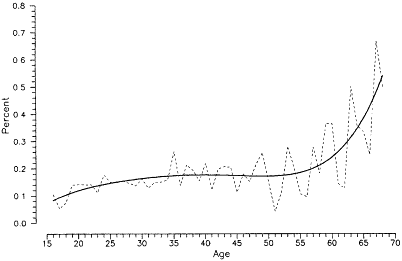
Fig. 11.10.
Proportion of workers reporting illness, by age, Michigan farm
laborers, 1894.
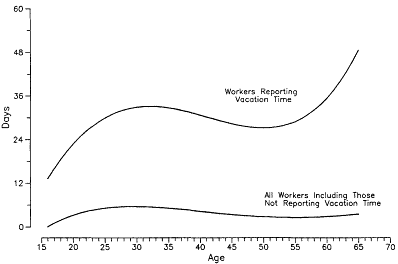
Fig. 11.11.
Age profile of days taken from work for vacation, California, 1892.
children to support than older men whose children were grown and might even be in a position to support them.
The fact that vacation time increases with age can be interpreted in two ways. Perhaps some workers reported time lost as voluntary when it was induced by fatigue or illness. It is also possible that older workers were able to "afford" more leisure time because of their success in building a stock of assets when they were younger. If so, we can think of vacation time as a form of partial or phased retirement. We note in this regard that the number of days taken as vacation time by older workers is greater than that taken by younger workers when one looks only at the distribution of those reporting some vacation time. Figure 11.11 presents this comparison for the California workers.
Conclusion
The analysis behind the findings reported in this chapter is descriptive and the results still somewhat provisional. Nevertheless, we find the profiles of wages, earnings, and time lost by age drawn from these rather diverse samples highly suggestive and intriguing. For all of the surveys we examined, both income and annual earnings of men aged 50 or older were distinctly less than those of men aged 30 to 45. We believe that the lower income reflected an industrial wage system that was based on physical productivity, which declined as the worker moved past middle age. The decline of in-
come of older workers, together with the discovery that the incidence of lost time rose dramatically for workers above the age of 45 or 50, reflected this decline in productivity. That time lost and incidence of illness increased with age is hardly surprising. However, the higher number of "days lost" suggests that older workers who did not have either a family-based form of economic security or assets accumulated over their lifetime were at substantial risk in the labor markets of the late nineteenth century. Because of this, the problem of economic security among older workers at the turn of the century was a major concern to working-class Americans.
A key question for economic historians in all this is whether the age profiles we examined in this chapter are reflective of a situation in which workers were able to anticipate their declining economic position and plan for retirement in old age through life cycle saving or whether this was a world in which older workers were caught in a vicious economic squeeze. The answer to that question is not apparent from the data presented above. However, there is considerable evidence that for a significant fraction of families in these surveys, a substantial portion of income was being saved during the middle of the life cycle, that assets were being accumulated by a majority of workers, and that late-life dis-saving was common. For those who succeeded in saving enough over previous years, retirement or substantially reduced work effort in late life became an option whether or not their health deteriorated. Of course, retired men were not in the samples of working families used as the basis for our analysis in this chapter. The estimates of labor force participation in 1900 and 1910 leave little doubt, however, that a sizable fraction of men did retire.
Appendix: Estimating the Age Profile of Variables in the Labor Surveys
The age profile curves in the figures presented in this chapter are smoothed polynomials derived from the raw data. To illustrate how these curves are generated, we present two examples of this technique as it was applied to determine the smoothed curves on age distribution of workers in Kansas (fig. 11.2) and the age profile of wages in Kansas (fig. 11.5). Figure 11.A1 presents the age distribution for the Kansas survey. In addition to the fitted line, we present the actual values for each age, which are then connected by a dashed line. Figure 11.A2 presents the raw data and a smoothed polynomial for daily wage rates in the Kansas survey. Each dot in the figure represents one (or more) worker. The smooth line is a seventh-degree polynomial fit through those points using ordinary least squares regression techniques. Figure 11.A3 plots the same smooth curve as a dashed line and for comparison also plots a jagged line connecting the mean wage rate for each age. The standard error about each respective mean is also represented by
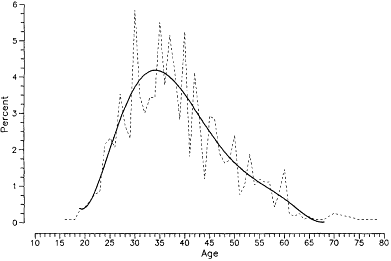
Fig. 11.A1.
Age distribution of respondents, Kansas,
1884-1887: Fitted line and actual values.
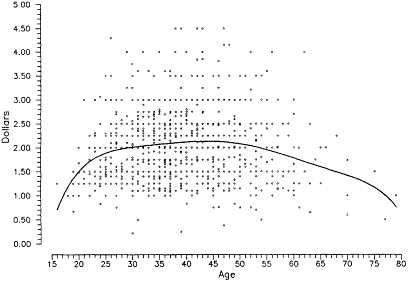
Fig. 11.A2.
Age profile of daily wage rates, Kansas,
1884-1887: Raw data and smoothed polynomial.
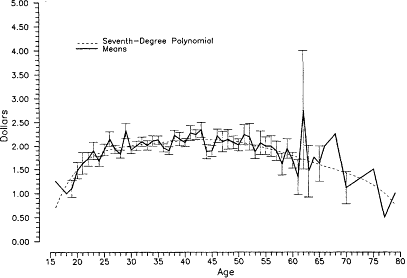
Fig. 11.A3.
Age profile of daily wage rates, Kansas,
1884-1887: Standard error of the means.
the vertical lines. Similar procedures were followed in the estimation of age profiles for earnings and days lost.
References
Achenbaum, W. Andrew. 1978. Old age in the new land: The American experience since 1790 . Baltimore: Johns Hopkins University Press.
Bancroft, Gertrude. 1958. The American labor force: Its growth and changing composition . New York: Social Science Research Council.
Bell, Spurgeon. 1940. Productivity, wages, and national income . Washington, D.C.: Brookings Institution.
California Bureau of Labor Statistics. 1892. Fifth biennial report, 1892 . Sacramento.
Carter, Susan B. 1988. "The changing importance of lifetime jobs, 1892-1978." Industrial Relations 27 (Fall): 287-300.
Carter, Susan B., and Peter Philips. 1990. "Technology, work organization and the gender gap in manufacturing wages, 1830-1980." In New developments in the labor market: Toward a new institutional paradigm , ed. Katherine G. Abraham and Robert B. McKersie, 213-238. Cambridge: MIT Press.
Carter, Susan B., Roger L. Ransom, and Richard Sutch. 1991. "The Historical Labor Statistics Project at the University of California." Historical Methods 24(Spring): 52-65.
Carter, Susan B., and Elizabeth Savoca. 1990. "Labor mobility and lengthy jobs in nineteenth-century America." Journal of Economic History 50 (March): 1-16.
———. 1991. "Gender differences in learning and earning in nineteenth-century America: The role of expected job and career attachment." Explorations in Economic History 28 (July): 323-343.
———. 1992. "The teaching procession? Another look at teacher tenure, 1845-1925." Explorations in Economic History 29 (October): 401-416.
Darby, Michael R. 1979. The effects of social security on income and the capital stock . Washington, D.C.: American Enterprise Institute.
Duggan, James E. 1984. "The labor force participation of older workers." Industrial and Labor Relations Review 37 (April): 415-430.
Eichengreen, Barry. 1984. "Experience and the male-female earnings gap in the 1890s." Journal of Economic History 44 (September): 822-834.
———. 1987. "The impact of late nineteenth-century unions on labor earnings and hours: Iowa in 1894." Industrial and Labor Relations Review 40 (July): 501-515.
Eichengreen, Barry, and Henry Gemery. 1986. "The earnings of skilled and unskilled immigrants at the end of the 19th century." Journal of Economic History 44(June): 441-454.
Goldin, Claudia. 1990. Understanding the gender gap: An economic history of American women . Oxford: Oxford University Press.
Hajnal, John. 1953. "Age at marriage and proportions marrying." Population Studies 7(November): 111-136.
Hannon, Joan Underhill. 1978. "The immigrant worker in the promised land: Human capital and ethnic discrimination in the Michigan labor market, 1889-1890." Ph.D. dissertation, Department of Economics, University of Wisconsin.
———. 1982a . "Ethnic discrimination in a 19th-century mining district: Michigan copper mines, 1888." Explorations in Economic History 19 (January): 28-50.
———. 1982b . "City size and ethnic discrimination: Michigan agricultural implements and iron working industries, 1890." Journal of Economic History 42 (December): 825-846.
Hansen, Alvin H. 1922. "Industrial classes in the United States in 1920." Journal of the American Statistical Association 18 (December): 501-508.
Iowa Bureau of Labor Statistics. 1885. First biennial report, 1884-5 . Des Moines: Geo. E. Roberts.
Kansas Bureau of Labor and Industrial Statistics. 1886. First annual report, January 1, 1886 . Topeka: T. D. Thatcher, State Printer.
———. 1887. Second annual report, January 1, 1887 . Topeka: T. D. Thatcher, State Printer.
———. 1888. Third annual report, January 1, 1888 . Topeka: Clifford C. Baker, State Printer.
Kotlikoff, Laurence J., and Lawrence H. Summers. 1981. "The role of intergenerational transfers in aggregate capital accumulation." Journal of Political Economy 89 (August): 706-732.
Lebergott, Stanley. 1964. Manpower in economic growth: The American record since 1800 . New York: McGraw-Hill.
Maine Bureau of Industrial and Labor Statistics. 1888. First annual report, 1887 . Augusta: Burleigh and Flynt, Printers to the State.
———. 1892. Fifth annual report, 1891 . Augusta: Burleigh and Flynt, Printers to the State.
Michigan Bureau of Labor and Industrial Statistics. 1895. Twelfth annual report of the Bureau of Labor, year ending February 1, 1895 . Lansing: Robert Smith and Co., State Printers and Binders.
———. 1889. Seventh annual report . Lansing: State Printer.
Modigliani, Franco. 1986. "Life cycle, individual thrift, and the wealth of nations." American Economic Review 76 (June): 297-313.
Moen, Jon. 1987. "The labor of older men: A comment." Journal of Economic History 47(September): 761-767.
Mushkin, S.J., and Alan Berman. 1947. "Factors influencing trends in employment of the aged." Social Security Bulletin 10 (August): 18-23.
New Jersey Bureau of Statistics of Labor and Industries. 1889. Twelfth annual report of the Bureau of Statistics of Labor and Industries of New Jersey for the year ending October 31, 1889 . Trenton: F. F. Patterson.
———. 1890. Thirteenth annual report of the Bureau of Statistics of Labor and Industries of New Jersey, for the year ending October 31, 1890 . Trenton: Electric Printing Company.
———. 1891. Fourteenth annual report of the Bureau of Statistics of Labor and Industries of New Jersey for the year ending October 31st, 1891 . Trenton: John L. Murphy.
Ransom, Roger L. 1990. "A proposal for a historical statistics archive." Cliometrics Newsletter (April): n.p.
Ransom, Roger L., and Richard Sutch. 1986a . "The labor of older Americans: Retirement of men on and off the job, 1870-1937." Journal of Economic History 46(March): 1-30.
———. 1986b . "Unequalled thrift: An inquiry into the saving behavior of Americans at the turn of the century." Paper presented to the American Economic Association, New Orleans, December.
———. 1987. "Tontine insurance and the Armstrong investigation: A case of stifled innovation, 1868-1905." Journal of Economic History 47(June): 379-390.
———. 1988. "The decline of retirement in the years before social security: U.S. retirement patterns, 1870-1940." In Issues in contemporary retirement , ed. Edward Lazear and Rita Ricardo-Campbell, 3-37. Stanford: Hoover Institution Press.
———. 1989a . "The trend in the rate of labor force participation of older men, 1870-1930: A reply to Moen." Journal of Economic History 49(March): 170-183.
———. 1989b . "Two strategies for a more secure old age: Life cycle saving by late nineteenth-century American workers." Working Papers on the History of Saving, no. 6, Institute of Business and Research, University of California, Berkeley.
Ransom, Roger L., Richard Sutch, and Samuel Williamson. 1991. "Retirement: Past and present." In Retirement and public policy: Proceedings of the second conference of the National Academy of Social Insurance , ed. Alicia H. Munnell, 23-57. Dubuque: Kendall Hunt.
U.S. Census Office. 1890. Eleventh census . Vol. 7. Mineral industries . Washington, D.C.: Government Printing Office.
Williamson, Jeffrey G. 1967. "Consumer behavior in the nineteenth century: Carroll D. Wright's Massachusetts workers in 1875." Explorations in Entrepreneurial History , 2d series, 4(Winter): 98-135.
Wright, Carroll D. 1902. Index of all reports issued by Bureaus of Labor Statistics in the United States prior to March 1, 1902 . U.S. Bureau of Labor. Washington, D.C.: Government Printing Office.
Twelve
Trends in Old Age Mortality in the United States, 1900-1935: Evidence from Railroad Pensions
George Alter
In his agenda for the historical demography of aging, Peter Laslett calls attention to the need for historical studies of survival at the oldest ages. Although our understanding of trends in mortality is informed by two centuries of European and almost one century of American vital registration, these data provide little guidance on trends in mortality at the oldest ages. Even in a large population, few people survive to the oldest ages, so the mortality rates at these ages are subject to large random errors. In addition, demographers and actuaries have always been mistrustful of the reporting of ages among the elderly. There is a well-documented tendency toward the overstatement of ages above 65 in both censuses and vital registration. Reliable evidence on old age mortality in the United States has only become available since 1940 with the advent of the Social Security system. This chapter will examine new evidence on old age mortality at the beginning of the twentieth century.
Although empirical data on mortality at the oldest ages are sparse, the length of the human life span and the shape of mortality at the oldest ages have been debated for a long time. Medical researchers have been intrigued by experimental evidence suggesting a biological limit to longevity (Sacher 1978; Strehler and Mildvan 1960). Actuaries and demographers have been searching for a mathematical representation of old age mortality (Benjamin 1982; Gompertz 1825; Le Bras 1976; Perks 1932). The Gompertz function, which has been used to approximate mortality at the oldest ages for more than a century, is widely considered less than satisfactory (Bayo 1972; Pakin and Hrisanov 1984). In the last decade interest in old age mortality was renewed by two new theoretical perspectives.
James Fries proposed that the twentieth century has witnessed a tendency toward the "rectangularization of the survival curve" (Fries 1983; Fries and
Crapo 1981). Fries uses official U.S. life tables from 1900 onward to argue that additions to the length of life have not resulted from any increase in the maximum human life span but rather from an increase in the number of people who approach the limits of human longevity. This evidence, he argues, is consistent with biological models of a limited life span. Fries is mainly interested in the implications of this pattern for health policy, and he advocates public health efforts directed toward "compressing" morbidity into the last years of life. Thus, although human life span would not increase, the period between the onset of chronic diseases and the end of life would be shortened. Unfortunately, as we shall see below, U.S. mortality data are not a reliable basis for this kind of analysis.[1]
An alternative perspective with dramatically different implications was introduced by Kenneth G. Manton, James W. Vaupel, and others who have called attention to the implications of heterogeneous "frailty" for the future course of mortality and morbidity. An influential 1979 article by Vaupel, Manton, and Eric Stallard showed that differences among individuals in susceptibility to disease and death can result in misleading trends in aggregate mortality. The term "frailty" has been used to describe differences in the likelihood of death among individuals in the face of a given set of environmental factors. When mortality is high, persons who are relatively more "frail" tend to die at younger ages, and the distribution of frailty among survivors at older ages is quite different from the distribution of frailty at birth. As the level of mortality declines, some individuals who would have died in earlier cohorts reach older ages. These "new survivors" tend to be more frail than those who would have survived when mortality was higher, and the average frailty of the elderly population increases.
Although the magnitude of this effect is still heatedly debated, it has important implications (Coale and Kisker 1986). Vaupel, Manton, and Stallard (1979) showed that changes in the average frailty of the surviving population tend to hide long-run changes in mortality rates at older ages. When mortality is declining, the increasing frailty of the older population offsets some of the reduction in the risk of death. Thus, if the underlying hazard of death was changing at the same rate at every age, old age mortality would appear to be declining more slowly. Indeed, the rising average frailty due to new survivors can lead to increasing mortality rates at some older ages, even though mortality for a hypothetical "standard" individual with a given genetic endowment would have been decreasing at every age.
George Alter and James C. Riley (1989) have explored the implications of frailty models for morbidity. Simulations in this study show that falling mortality can result in rising morbidity as relatively frail individuals have longer lives but are still more likely to become ill. The tendency of some medical interventions to lengthen life without restoring health has been
called the "failures of success" (Gruenberg 1977). This is a perspective quite contrary to the implications derived by Fries (see also Riley 1989).
The available evidence on trends in old age mortality in the United States shows them to have been much less consistent than those at younger ages. While mortality has declined more or less continuously at younger ages, progress at older ages has been slow and halting. There have been periods in which mortality decline at the oldest ages stopped and a natural limit on the human life span appeared to have been reached (Fingerhut 1982; Olshansky, Carnes, and Cassel 1990).
The divergent trends in young and old age mortality were very dramatic in the early part of this century. Table 12.1 compares probabilities of death by age in 1901 and 1930 from U.S. life tables for the ten states with reliable death registration in 1901. The table shows rapid progress in reducing mortality at all of the younger ages. The probability of death in five years fell by 40 percent or more at every age under 40. There was almost no change in old age mortality, however.
TABLE 12.1 | |||
5 qx | |||
Age | 1901 | 1930 | Percent Change |
0 | 0.1914 | 0.0838 | -56.2 |
5 | 0.0217 | 0.0107 | -50.5 |
10 | 0.0136 | 0.0082 | -39.7 |
15 | 0.0213 | 0.0124 | -41.7 |
20 | 0.0323 | 0.0160 | -50.5 |
25 | 0.0364 | 0.0174 | -52.1 |
30 | 0.0418 | 0.0211 | -49.6 |
35 | 0.0482 | 0.0281 | -41.7 |
40 | 0.0552 | 0.0396 | -28.3 |
45 | 0.0667 | 0.0552 | -17.2 |
50 | 0.0835 | 0.0785 | -6.0 |
55 | 0.1150 | 0.1117 | -2.9 |
60 | 0.1551 | 0.1580 | 1.9 |
65 | 0.2193 | 0.2207 | 0.6 |
70 | 0.3020 | 0.3098 | 2.6 |
75 | 0.4265 | 0.4290 | 0.6 |
80 | 0.5718 | 0.5702 | -0.3 |
85 | 0.7100 | 0.7008 | -1.3 |
SOURCES : Glover 1921; Hill 1936. | |||
This chapter investigates old age mortality in this period of rapid progress at the younger ages. Annual series of mortality rates at older ages seem to show increasing mortality, with a peak around 1926. This pattern attracted the attention of influential researchers, such as the public health reformer Edgar Sydenstricker (1933) and the actuary Louis Dublin (Metropolitan Life Insurance Company 1929b ). However, it was by no means certain that the trend had really changed. These apparent increases may have been an echo of the 1918-1919 influenza epidemic or a result of temporary conditions in the 1920s.[2] Furthermore, as noted above, mortality at the oldest ages is always difficult to measure.
The evidence presented here supports the conclusion that an increase in old age mortality did occur in the early twentieth century. Data from three sources will be described: vital registration from the death registration area of 1900, the Pennsylvania Railroad Pension Fund, and an investigation of all railroad pensions by the Federal Coordinator of Transportation. The railroad pension fund data are important, because they are not subject to the age misreporting that seriously impairs the usefulness of censuses and vital registration. These data sets differ in methodology and geographic coverage, but they provide a consistent picture of old age mortality. All these data suggest that mortality above age 80 was either stable or rising in the first third of this century.
Trends in U.S. Vital Rates
The United States was one of the last industrial countries to develop comprehensive vital registration. Vital registration was the responsibility of the individual states. Massachusetts was the first state to establish a reliable death registration system, and its records are considered complete from about 1870 (Gutman 1956). The U.S. Bureau of the Census began publishing mortality statistics beginning with 1900 for the states and cities in which adequate registration was available. This "original" registration area covered ten states (the six New England states, Indiana, Michigan, New Jersey, and New York) and the District of Columbia. States were added to the registration area as their records were found to be complete. The registration area had expanded to 20 states in 1910, 34 states in 1920, and 47 states in 1930. The death registration system was completed in 1933 when Texas was added.
The gradual expansion of the registration area often confuses the picture of mortality trends in this period. Registration was established first in northeastern states. On balance, these were more industrial and more urban than the southern and western states added later. The early registration states also had fewer nonwhites and more recent immigrants. The net effect of these differences was higher mortality in states with earlier registration. Consequently, mortality tables constructed from the expanding registration
area tend to show a decline in mortality, which is an artifact of changing geographic coverage.
Figures 12.1 and 12.2 show age-specific death rates for ages 65-74, 75-84, and 85 and older from 1900 to 1940 for white males and white females in the original registration states. Each of these curves tells a similar story. There appears to have been constant or slightly rising mortality from about 1900 to 1920, a peak in mortality in the mid-1920s, and declining mortality in the late 1920s and 1930s. These visible patterns are confirmed in table 12.2, which shows regression lines fitted by ordinary least squares. The coefficients for the year in these equations estimate the annual decrease in the age-specific death rates. For the entire period from 1900 to 1940, downward trends are found in five of the six series. When only the period from 1900 to 1929 is considered, however, all six series produce upward trends. Furthermore, the rates of increase are correlated with age. The annual increase in the death rate for white males rises from 0.054 per thousand at ages 65-74 to 0.361 per thousand at ages 85 and over. The corresponding estimates for white females are 0.001 and 0.892, respectively. Mortality at ages below 65 was decreasing. Thus there was an overall shift from falling mortality at younger ages to rising mortality at the oldest ages from 1900 to 1929.
The age-specific death rates from vital registration are suspect, however, because of the tendency toward age overstatement at the highest ages. The death rates shown in figures 12.1 and 12.2 are ratios of deaths reported in vital registration and population estimates derived from censuses. Errors in both sources are suggested by the Matching Record Study, which compared ages reported in the 1960 census to a sample of deaths registered in the following year (Hambright 1968). Discrepancies between the census and death certificates were greatest at the oldest ages, and the results of the study
TABLE 12.2 | |||||||
White Male | White Female | ||||||
65-74 | 75-84 | 85+ | 65-74 | 75-84 | 85+ | ||
1900-1940 | |||||||
Year | -0.045 | 0.025 | -0.505 | -0.170 | -0.099 | -0.466 | |
Constant | 146.5 | 81.3 | 1228.4 | 379.1 | 306.9 | 1142.2 | |
R2 | 0.047 | 0.004 | 0.146 | 0.423 | 0.053 | 0.076 | |
1900-1929 | |||||||
Year | 0.054 | 0.256 | 0.361 | 0.001 | 0.232 | 0.892 | |
Constant | -43.4 | -360.1 | -425.9 | 51.8 | -325.5 | -1452.1 | |
R2 | 0.032 | 0.185 | 0.051 | 0.000 | 0.185 | 0.183 | |
SOURCE : Linder and Grove 1963. | |||||||
NOTE : Dependent variables: Age-specific death rates. Independent variable: Year. | |||||||
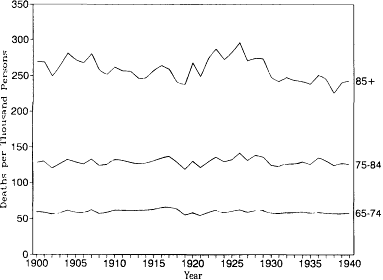
Fig. 12.1.
Age-specific death rates, 1900-1940: White
males, U.S. death registration states of 1900.
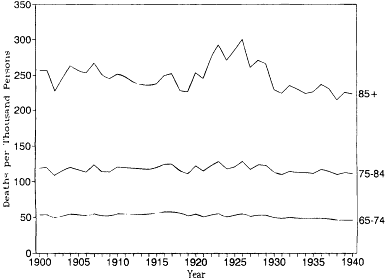
Fig. 12.2.
Age-specific death rates, 1900-1940: White
females, U.S. death registration states of 1900.
are consistent with a hypothesis of roughly equal age misreporting in both sources. It is likely that age misreporting at the beginning of this century was even more common than it was in 1960.
Since age overstatement tends to be dominant at the oldest ages, the reported age-specific death rates at these ages include some experience of younger people. We can consider the problem in the following way. When age misreporting is present, the observed mortality rate at a given age is a weighted average of the mortality rates of three groups: (1) those who are younger than the reported age, (2) those who are reported at their true age, and (3) those who are older than the reported age. Persons whose ages are overstated (group 1) tend to lower observed mortality, because younger persons have lower mortality rates. Age understatement (group 3) tends to increase mortality by erroneously including older persons in younger age groups. The amount of bias in the observed mortality rate depends on both the numbers of younger and older persons whose ages are misreported and on the differences in mortality at true and observed ages.[3]
Age misreporting will have little effect on the observed death rate when the proportions misreported from younger and older ages are approximately equal. This tends to be the case at the younger adult ages, but it is not likely to occur at the oldest ages. First, there is a tendency for more age overstatement than understatement at these ages. Second, at the upper ages there are many fewer people at older than at younger ages. The high mortality rates at these ages impart a steep slope to the population distribution, which puts more people at risk of age overstatement than age understatement. All of the errors in the final, open-ended age category are errors of age overstatement. Thus age misreporting results in an influx from younger to older age groups. These younger individuals experience mortality rates lower than those of the age groups in which they are reported. This results in an underestimate of the death rates at the oldest ages (Coale and Kisker 1986).
Trends in observed mortality rates will be affected by changes in both age misreporting and in the underlying true mortality rates. On one hand, improvements in age reporting will result in an upward trend in the observed mortality rates at older ages. As the proportions incorrectly reported in higher age groups decline, the mortality rates at these higher ages will tend to increase. On the other hand, a downward trend in mortality at younger ages will tend to produce a decline in mortality at older ages as well. Individuals impart the trends in their true mortality rates to the categories in which they are reported.
The death rates in the U.S. registration area would have been subject to both of these effects. It is possible that age reporting was improving at this time. Ansley J. Coale and Melvin Zelnik (1963) estimated decreasing enumeration errors at most adult ages for the censuses of 1900 to 1930. How-
ever, the population aged 85 and over was still significantly overcounted in the 1930 census. Preliminary estimates using stable population methods suggest that at least 10 and possibly more than 25 percent of those reported as 85 and over were really younger than 85 (Alter 1990). This factor would lead to an understatement of the upward trend at these older ages. Thus the effects of improved age reporting were probably offset by declining or less rapidly increasing mortality at younger ages.
On balance, the upward trend in old age mortality observed in the U.S. death registration states appears to be real. It is unlikely that the peak in mortality in the mid-1920s was caused by changes in age reporting.
The Pennsylvania Railroad Pension Fund
Tabulations of the mortality experience of the Pennsylvania Railroad Pension Fund are available from its inception in 1900. The Pennsylvania Railroad was one of the first corporations to provide modern employee benefits. Sickness insurance and death benefits had been introduced in 1886, and in 1889 the company decided to give pensions to all workers above the age of 70. The new program included mandatory retirement at age 70, and the amount of the pension was based on earnings before retirement. Pensions were also provided for disabled workers aged 65-69 with thirty years of service. To limit future eligibility to long-term employees, the railroad also restricted the hiring of new workers to applicants under age 35.
Annual reports included in the minutes of the Board of Officers of the Pennsylvania Railroad Pension Fund have been used to calculate age-specific death rates. These records fall into two periods. Before 1920, the company was divided into eastern and western operating divisions, and a separate pension fund was maintained for workers in the railroad lines west of Pittsburgh. In 1920, the two pension funds were united, as part of a general reorganization of the company. The board of the smaller western fund did not tabulate its pensioners by age, so mortality rates presented here for 1900 to 1919 refer only to the eastern division of the company. Mortality rates for 1921 to 1936 refer to both divisions combined. In 1957, all railroad pensions were taken over by the Railroad Retirement Board, and the Pennsylvania Railroad Pension Fund limited its activities to providing for workers who did not meet the requirements of the new national system. Annual age-specific mortality rates are not available after the formation of the Railroad Retirement Board.
The Pennsylvania Railroad was the largest corporation in the United States during the nineteenth century, and its pension obligations at the beginning of this century were correspondingly large. By the end of its first year in operation, the fund supported 1,190 pensioners, including 1,054 who were age 70 or older, and 735 more workers retired in 1901. In 1920
when the western lines were added, there were 5,776 pensioners who were almost equally divided between ages 65-69 and 70 and older. At the end of 1936, when the fund was turned over to the U.S. Railroad Retirement Board, there were 11,682 pensioners, 3,428 of whom were aged 70 or more.[4]
Tabulations of mortality by attained age for the lines west of Pittsburgh are not available before the two operating divisions were merged in 1920. However, evidence on mortality in each region by age at retirement suggests that the difference between regions was negligible. Table 12.3 compares mortality in the eastern and western operating divisions for the years 1910 to 1919. Among those who retired at age 70 or older, mortality was nearly the same in each region, 103.4 deaths per thousand in the east compared to 103.9 in the western lines. The difference was somewhat higher for disability retirements at ages 65-69: 89.4 and 96.8 per thousand, respectively. Although these differences do indicate that mortality may have been slightly higher in the lines west of Pittsburgh, they do not represent significant differences.
Reporting of Ages
The pension fund records do not seem to suffer from the kinds of age mis-reporting that affect other sources of mortality information. Retirements were based on dates of birth already recorded in company personnel files. Since these dates of birth were reported at young adult ages, they would not have been subject to the systematic overstatement common at the older ages. Reporting is also likely to be more accurate when respondents are asked for their date of birth rather than their age, because there is less tendency to round years of birth.[5]
If workers were tempted to misstate their ages, they probably would have reported themselves as younger rather than older. Even before the com-
TABLE 12.3 | ||||
Age at Retirement | ||||
70 + | 65-69 | Total | ||
Number of deaths | ||||
East | 1,800 | 1,462 | 3,262 | |
West | 803 | 320 | 1,123 | |
Number of lives at riska | ||||
East | 17,407.5 | 16,354.5 | 33,762.0 | |
West | 7,731.0 | 3,305.5 | 11,036.5 | |
Death rate | ||||
East | 0.1034 | 0.0894 | 0.0966 | |
West | 0.1039 | 0.0968 | 0.1018 | |
a Number on December 31 of preceding year plus one-half the number who retired during the year. | ||||
pany banned the hiring of workers above the age of 35, younger workers were probably preferred. As retirement age approached, workers whose ages were understated could choose between continued employment or having their records corrected so that they could retire on time.
The minutes of the Board of Officers of the pension fund suggest that the company did attempt to keep its records accurate. Ages could often be checked by comparing different company files, because most workers would have reported their dates of birth more than once. The board considered a number of resolutions that would correct the dates of birth recorded in company files. For example, in 1919, the Board of Officers received a letter requesting the cancellation of mandatory retirement proceedings for a certain worker. The superintendent who wrote the letter claimed to have in his possession a family Bible proving that the correct date of birth was 1854, not 1848 (Pennsylvania Railroad Pension Fund, January 1, 1919).
An important indication of the accuracy of the ages reported in the pension records is the rarity of centenarians in these data. Only two pensioners reached the age of 102, and none exceeded that age. Individuals over the age of 100 are much more common when ages are poorly reported, and deaths are often found at ages 110 and over when age reporting is unreliable.
Selectivity and Representativeness
The mortality experience found in insurance, pensions, and annuities is usually not a representative sample of the entire population. These records differ in two important ways. First, the criteria for admission to these programs are often related to health. For example, insurance companies try to eliminate high-risk cases by requiring medical examinations. In general, the individuals included in insurance and pension records are healthier than the average population. Second, financial aspects of insurance and pensions often limit them to social and economic groups with special characteristics. Both of these problems affect the comparison between the Pennsylvania Railroad pensioners and the general population. For purposes of discussion, the first of these problems will be called "selectivity" and the second, "representativeness."
Actuaries have long been aware that mortality tables derived from insurance records often differ substantially from those based on the general population. The mortality of insurees tends to be particularly low in the first few years after the contracts begin, because persons with detectable disabilities are either refused insurance or placed in special high-risk categories. Pension records usually suffer from a similar selection bias known as the "healthy worker effect" (Fox and Collier 1976). Workers who retire at the mandatory age limit tend to be healthier than those who stop working at earlier ages. Mortality tables based on the experiences of disabled workers show much lower life expectancies than those based on active workers.
These selection effects lead us to expect lower mortality in the railroad pension records than we would see in the general population.
The difference between select and general populations is not constant, however. As the duration of the contract increases, the advantage due to selection diminishes for two reasons. On one hand, most health risks cannot be forecast very far into the future, so the select experience begins to approach the general experience. On the other hand, the high-risk individuals in the general population die more rapidly than others, which brings the average experience closer to the select experience. Most of the effects of selection are gone after five years, and only minor differences exist after ten years.
The rules of the Pennsylvania Railroad Pension Fund removed some of the impact of the selection in the data used here. Although the age of mandatory retirement was 70, workers became eligible for a disability pension at age 65. As we would expect, the mortality of disability retirees between ages 65 and 70 was very high. The disability provision of the pension meant that workers were selected into the pension system at age 65, even though most workers only began receiving benefits at age 70. Thus the healthy worker effect is reduced in these data, because pensioners have already been in the system for five years by age 70. There is some evidence of select mortality at ages 71 and 72, but this effect is gone by age 75.
An additional kind of selection bias can occur when a new program is introduced. The healthy worker effect is probably stronger for employees who retired in the first year of the new pension program than for those who retired later. The first cohort of pensioners did not benefit from the possibility of earlier disability pensions, and many of those who retired in 1900 and 1901 were above age 70 at retirement. Abraham M. Niessen (1948) notes that mortality rates in the first two years of the U.S. Railroad Retirement Board were lower than subsequent experience. A similar effect in the Pennsylvania Railroad pension data is described below.
There is no way to manipulate the pension fund data to make it approximate a random sample of the entire population, but railroad employees seem to be as close to a representative sample of white males as we are likely to find. A breakdown of the Pennsylvania Railroad pensioners by race and sex is not available. However, 93 percent of the early beneficiaries of the U.S. Railroad Retirement Board were white males (Niessen 1948).[6] We also know that the Pennsylvania Railroad Pension Fund applied to all employees of the railroad, company officers as well as manual workers. Since the railroad employed an extensive workforce with a large segment of clerks and other non-manual employees, its distribution of workers by social status is probably closer to the national pattern than a manufacturing firm would be.
Douglas Ewbank has provided me with estimates of infant and child mortality comparing railroad employees to the rest of the population. The esti-
mates are based on reports of surviving children and children ever born in vital registration for the year 1928, and they refer to mortality conditions in approximately 1923. Ewbank has estimated child mortality rates of 0.1323 for railroad employees aged 20-39 and 0.1329 for the total population, a difference of less than 1 percent.[7] Since infant mortality and child mortality are very sensitive to living conditions, we can conclude that railroad workers were not subject to any unusual nonoccupational sources of mortality. Thus railroad workers, if not a representative sample, are at least a close approximation to the national average.
Calculating Mortality Rates
Information in the minutes of the Board of Officers has been used to calculate probabilities of dying for single years of age beginning at age 71. From 1900 to 1936, we have reports giving the number of pensioners by age at last birthday on December 31 of each year. From 1900 to 1919, the reports also give the number of new pensioners and deaths at each age, but after 1919, only the total numbers of new pensioners and deaths are given. Two years are missing from the series. The table for 1902 could not be located. In 1920, the merger of pensioners from lines west of Pittsburgh and changes in reporting procedures made it impossible to compute death rates.[8]
Death rates were computed by dividing the number of deaths by lives at risk. Lives at risk were computed as the sum of the number of pensioners on December 31 of the preceding year and one-half the number who retired during the year. After 1920, the totals of deaths and retirements must be distributed to single years of age. The age distribution of retirees in the years 1917-1919 was used to assign ages to retirees, and deaths were computed by subtracting the number of survivors at the end of the year. Since the overwhelming majority of nondisability retirements occurred at ages 70 or 71, any errors in assigning ages at retirement are minor and have almost no effect after age 75. Annual variations in the distribution of retirements by age are further mitigated by the procedure used to convert mortality estimates to exact ages.
The tables included in the minutes of the pension fund show ages tabulated by age at last birthday. Simple procedures have been used to compute age-specific mortality rates for exact ages in standard life table form. We assume that the population whose age at last birthday was x can be treated as a population aged exactly x + 1/2. This is a reasonable approximation for data given by single year of age. Probabilities of death for exact ages (1 qx ) are derived by computing two-year moving averages.[9]
Trends in Mortality by Age
Figure 12.3 shows annual movements in probabilities of death at ages 71, 75, 80, and 85 (4 q71 , 5 q75 , 5 q80 , and 5 q85 ) for 1900 to 1936 derived from the Penn-
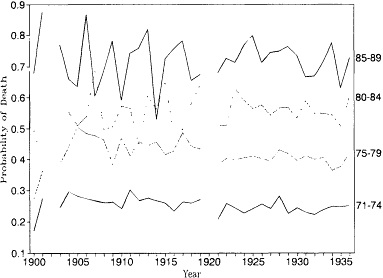
Fig. 12.3.
Probability of death, by age: Pennsylvania Railroad
Pension Fund, 1900-1935.
sylvania Railroad Pension Fund data. In table 12.4 and figures 12.4 through 12.7, these mortality rates are aggregated into five-year periods centered on years ending in 5 and 0. The mortality rates for ages 71-74 have been extrapolated to ages 70-74 to facilitate comparison with U.S. life tables (also presented in table 12.4 and figs. 12.4-12.7). Trends are easier to detect in these figures without the confusing influence of annual fluctuations.
The influence of the selection effects described above are apparent in the first two years of the pension fund. The mortality rates for ages 71-74 were noticeably lower in the first two years of the pension fund, because currently employed workers tend to be healthier than those who retire early. This effect disappeared relatively quickly as disability pensions at age 65 became available, however.
The most remarkable aspect of these data is the difference between the trends in mortality above and below age 80. The mortality rates at ages 71-74 and 75-79 show clear and steady declines between 1905 and 1935. It is much more difficult to detect trends at the two older age groups. The age group 80-84 has a generally rising pattern with the suggestion of a peak around 1925. Ages 85-89 also peak near 1925, but the overall trend is even more difficult to identify.
Table 12.4 and figures 12.4 through 12.7 show life table mortality estimates for the U.S. death registration area. Joseph A. Hill (1936) provides
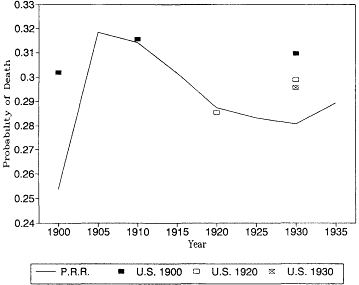
Fig. 12.4.
Probability of death at age 70: Pennsylvania Railroad Pension
Fund, 1900-1935, and U.S. Life Tables, 1900, 1920, and 1930.
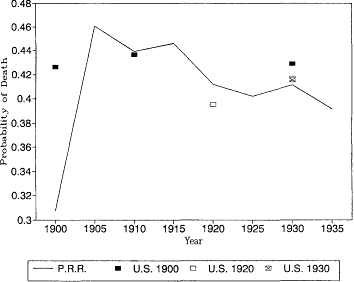
Fig. 12.5.
Probability of death at age 75: Pennsylvania Railroad Pension
Fund, 1900-1935, and U.S. Life Tables, 1900, 1920, and 1930.
TABLE 12.4 | |||||||||
Pennsylvania Railroad Pension Fund | |||||||||
Aged | 1900-1901 | 1903-1907 | 1908-1912 | 1913-1917 | 1918-1922 | 1923-1927 | 1928-1932 | 1933-1936 | |
70 | 0.2537 | 0.3186 | 0.3143 | 0.3018 | 0.2876 | 0.2833 | 0.2808 | 0.2893 | |
75 | 0.3077 | 0.4608 | 0.4394 | 0.4461 | 0.4119 | 0.4021 | 0.4114 | 0.3917 | |
80 | 0.4765 | 0.5616 | 0.5176 | 0.5581 | 0.5546 | 0.5803 | 0.5610 | 0.5520 | |
85 | 0.7584 | 0.7097 | 0.7311 | 0.7297 | 0.6860 | 0.7504 | 0.7099 | 0.7152 | |
90 | 0.8284 | 0.8683 | 0.8670 | 0.8189 | 0.8176 | 0.8516 | |||
95 | 0.8808 | 0.6915 | 0.9613 | ||||||
U.S. White Male Life Tables | |||||||||
1901 | 1910 | 1920 | 1930 | ||||||
Contemporary U.S. death registration area | |||||||||
70 | 0.3019 | 0.3156 | 0.2854 | 0.2958 | |||||
75 | 0.4265 | 0.4366 | 0.3955 | 0.4157 | |||||
80 | 0.5718 | 0.5769 | 0.5382 | 0.5603 | |||||
85 | 0.7101 | 0.7040 | 0.6850 | 0.6889 | |||||
90 | 0.8274 | 0.8103 | 0.7835 | 0.8041 | |||||
95 | 0.9179 | 0.8940 | 0.8907 | 0.9125 | |||||
(Table continued on next page)
(Table continued from previous page)
U.S. White Male Life Tables | |||||||||
1901 | 1910 | 1920 | 1930 | ||||||
Registration states of 1900 | |||||||||
70 | 0.3019 | 0.3156 | 0.3098 | ||||||
75 | 0.4265 | 0.4366 | 0.4290 | ||||||
80 | 0.5718 | 0.5769 | 0.5702 | ||||||
85 | 0.7101 | 0.7040 | 0.7008 | ||||||
90 | 0.8274 | 0.8103 | 0.8122 | ||||||
95 | 0.9179 | 0.8940 | 0.9055 | ||||||
Registration states of 1920 | |||||||||
70 | 0.2854 | 0.2989 | |||||||
75 | 0.3955 | 0.4170 | |||||||
80 | 0.5382 | 0.5602 | |||||||
85 | 0.6850 | 0.6908 | |||||||
90 | 0.7835 | 0.8039 | |||||||
95 | 0.8907 | 0.9170 | |||||||
Registration states of 1930 | |||||||||
70 | 0.2958 | ||||||||
75 | 0.4157 | ||||||||
80 | 0.5603 | ||||||||
85 | 0.6889 | ||||||||
90 | 0.8041 | ||||||||
95 | 0.9125 | ||||||||
a The probabilities of death for ages 71-74 have been converted to 70-75 using the formula 5 q70 = 1.169 4 q71 . | |||||||||
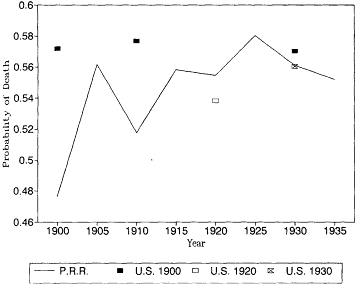
Fig. 12.6.
Probability of death at age 80: Pennsylvania Railroad Pension
Fund, 1900-1935, and U.S. Life Tables, 1900, 1920, and 1930.
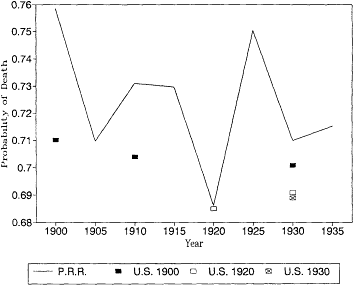
Fig. 12.7.
Probability of death at age 85: Pennsylvania Railroad Pension
Fund, 1900-1935, and U.S. Life Tables, 1900, 1920, and 1930.
U.S. life tables for 1930 based on the death registration areas of 1900 and 1920. At most younger ages the differences between the earlier and later registration areas would not change our interpretation of the trend in mortality. At these ages, however, the expanding death registration area suggests a larger decline in mortality than the original registration states of 1900. In 1930, the estimates based on the 1.900 death registration area are higher than the other two estimates, and the 1930 death registration area yields the lowest mortality rates of all.
It is also reassuring to see that the Pennsylvania Railroad pension mortality was very close to the more general experience captured by the U.S. Bureau of the Census life tables. There is no evidence here that the railroad annuitants were select lives with lower than normal mortality. At age 85 the railroad mortality rates are higher than the U.S. life table estimates. This is probably due to age misreporting errors in the U.S. data, which were discussed above.
A statistical analysis of mortality trends at different ages is presented in table 12.5. Logit regression models have been used to estimate the relationships among age, time period, and the age-specific mortality rates of the Pennsylvania Railroad Pension Fund. The dependent variable in this analysis is the set of death rates for single years of age (lqx) in each of the years from 1903 to 1935. Death rates based on fewer than 10 lives at risk were excluded, which left 649 observations for the full period. Logit regression was used because the range of the dependent variable is restricted to the interval from 0 to 1. This restriction results in heteroskedasticity, which biases standard errors derived from ordinary least squares regressions. Observations were weighted by the number of lives at risk in all computations.[10] Estimates are provided for three periods. The first period, 1903-1935, uses all of the available data except for the three initial years of the pension fund, which show strong selectivity effects. The second period, 1903-1929, excludes the last six years of the pension fund, in which mortality appears to have been falling at all ages. The third period, 1903-1919, refers to data for only the eastern operating division of the railroad and excludes the possible confounding effects of the western lines added when the two pension funds merged in 1920.
Model I provides a simple estimate of the relationship between age and mortality without distinctions by time period. The logit model of mortality is similar to the Gompertz model, which is more commonly used to approximate adult mortality.[11] In both models the logarithm of the probability of death is almost linear at younger ages, but it increases more slowly at the highest ages as it converges toward 1.0. The estimated coefficient for age in this model represents the rate of increase in the probability of death as age increases. The desirability of additional parameters in modeling the Pennsylvania Railroad Pension Fund data was tested by adding an age-
TABLE 12.5 | ||||
Years | ||||
1903-1935 | 1903-1929 | 1903-1919 | ||
Model I | ||||
Constant | -9.238* | -9.210* | -8.542* | |
Age | .0927* | .0927* | .0845* | |
Model II | ||||
Constant | -9.274* | -9.256* | -8.545* | |
Age | .0932* | .0930* | .0845* | |
Year | -.0044* | -.0040* | -.0002 | |
Model III | ||||
Constant | -9.252* | -9.502* | -8.966* | |
Age | .0929* | .0962* | .0901* | |
Year | -.0057* | -.0062* | -.0014 | |
Year for age 80+ | .0057* | .0096* | .0061 | |
Model IV | ||||
Constant | - 9.252* | - 9.502* | - 8.966* | |
Age | .0929* | .0962* | .0901* | |
Year for ages 71-79 | -.0057* | -.0062* | -.0014 | |
Year for age 80+ | .0000 | .0034 | .0046 | |
NOTE : Dependent variable is life table lqx. | ||||
* The probability of obtaining this result if the true coefficient equals zero is p < .05. | ||||
squared term to the logit regression. This additional term did not improve the fit of the model significantly.
The estimates in table 12.5 support the impression that the shape of the mortality curve was changing. If mortality at ages 70-79 was decreasing and mortality above age 80 was constant or increasing, the rate of increase of the probability of death with advancing age should have become more pronounced. This is exactly the kind of change that we find in Model I by comparing the estimates for 1903 to 1919 to the estimates for 1903 to 1929 or 1903 to 1936. The estimated coefficient for age increases from 0.0845 in the earlier period to 0.0927 when the 1920s and 1930s are included.
In Model II, the year is added as an independent variable in the logit regression equation. This allows the level of the mortality curve to shift upward or downward over time. The estimates for all three periods indicate that mortality was falling, but the change from 1903 to 1919 is not statistically distinguishable from zero.
Models III and IV allow us to distinguish between the trends in mortality at ages 71-79 and trends over the age of 80. These models are actually mathematically identical, but they yield tests of somewhat different statisti-
cal inferences. In Model III, a variable is added to distinguish trends in mortality at ages 80 and over from the trend at ages 71-79. This variable is set equal to the year at ages 80 and over but is set to zero under age 80. In Model III, the coefficient for the independent variable "Year" measures the rate of change of mortality at ages 71-79, and the coefficient for "Year for age 80+" measures the difference between the rate of change at ages 80 and over and ages 71-79. The estimated coefficients for this "interaction" variable indicate that mortality decreased less above age 80 in each of the three periods. The difference in trends is greatest for the period 1903 to 1929, and the differences in the periods 1903 to 1929 and 1903 to 1936 are both statistically significant.
In Model IV, the variable for the year is replaced with a variable that is equal to the year at ages 71-79 and zero at ages 80 and over. Since this change does not add any new information, the estimated coefficients for this independent variable are the same as those for the variable that is replaced in Model III. However, the interpretation of the variable "Year for age 80+" is different in Model IV. This variable now provides a direct measure of the trend in mortality at ages 80 and older, instead of measuring the difference between trends above and below age 80. In Model IV, the statistical test associated with this variable considers the null hypothesis that there was no trend in mortality at ages 80 and over. In the previous model the null hypothesis was that there was no difference between the trend at ages 71-79 and the trend at 80 and older.
Model IV indicates that mortality was increasing above age 80 until 1929. When the seven years from 1930 to 1936 are included, however, there is no measurable trend above age 80. This pattern is consistent with other indications in both the Pennsylvania Railroad Pension Fund and the death registration states that old age mortality peaked in the 1920s and declined in the 1930s. It is also noteworthy that the period 1903 to 1919 shows a stronger upward trend at ages 80 and older and a weaker downward trend at ages below 80. This suggests that the mortality peak in the mid-1920s is not due to changes in composition of the pension fund after the western lines were added in 1920. We cannot attach much certainty to the inference that mortality above age 80 was rising, because the statistical tests on Model IV indicate that the estimated coefficients for the "Year for age 804+" variable could differ from zero because of random variations in the data.
The logit regression models in table 12.5 provide statistical confirmation of the impressions derived from figures 12.4 through 12.7. Mortality below age 80 was declining, and there was a significant difference between the trends in mortality above and below age 80. The estimated coefficients indicate that mortality above age 80 was rising in the period from 1903 to 1929, but the statistical tests do not reject the null hypothesis that mortality at these ages was constant.
Thus these data from the Pennsylvania Railroad Pension Fund support the evidence from U.S. vital registration. Both data sets show divergent trends in mortality, at the older and younger ages. Furthermore, both data sets point to a turning point around 1926, when mortality at the oldest ages peaked and began to decline.
Federal Coordinator of Transportation
In 1934, the Federal Coordinator of Transportation, a short-lived branch of the U.S. government, conducted a major study of employment and pension histories of railroad workers. This was undoubtedly one of the largest studies of its kind ever conducted. The study was motivated by concern for employment during the economic depression and the emerging crisis among railroad pension funds. More than 300,000 employment histories from thirteen railroads and pension histories of 109,096 former male workers from fifty-nine railroads were collected.[12] The pension histories record 644,417 years of experience and 59,165 deaths. In 1940, the U.S. Railroad Retirement Board compiled the results of this survey for use in its actuarial valuation of the railroad pension system.
Since the pension programs examined by the Federal Coordinator of Transportation differed substantially in their provisions, it was necessary to organize them into the six classes shown in table 12.6. Classes 1 and 2 include pension records for workers forced to retire at a compulsory retirement age. In the programs included in class 1, most workers retired at the compulsory age, but in class 2, a substantial percentage of retirements occurred before or after the compulsory retirement age. Classes 3, 4, and 5 identify three kinds of disability retirements. Workers in class 3 were deemed permanently and totally disabled from "any occupation." The disabilities in class 4 were subjected to the less stringent requirement of disability from engaging in the "usual" occupation. The pension programs in class 5 did not distinguish between "any occupation" and "usual occupation." Railroads that allowed both disability and age retirements, such as the Pennsylvania Railroad, contributed histories to class 5 as well as to class 1 or 2. The railroads in class 6 had only disability retirement or did not distinguish between age and disability retirements.
Table 12.6 shows the number of person years of experience in each class of retirement program for workers who retired in three periods: in 1910 or earlier, 1911 to 1920, and 1921 to 1930. The retirement systems with the largest numbers of workers combined compulsory age retirements with disability retirement at older ages. More than half of the experience in these two categories was contributed by the two largest pension systems, the Pennsylvania Railroad (27,431 retirements) and the New York Central Railroad (13,396 retirements). The second panel of the table, presenting the per-
TABLE 12.6 | |||||
Year of Retirement | |||||
Class of Retirementa | Before 1910 | 1911-1920 | 1921-1930 | ||
Number of retirements | |||||
1 | 3,963 | 7,936 | 19,371 | ||
2 | 275 | 1,359 | 7,962 | ||
3 | 276 | 383 | 892 | ||
4 | 46 | 227 | 557 | ||
5 | 3,056 | 9,702 | 30,414 | ||
6 | 718 | 3,433 | 13,483 | ||
Total | 8,334 | 23,040 | 72,679 | ||
Percent of retirements | |||||
1 | 47.6 | 34.4 | 26.7 | ||
2 | 3.3 | 5.9 | 11.0 | ||
3 | 3.3 | 1.7 | 1.2 | ||
4 | 0.6 | 1.0 | 0.8 | ||
5 | 36.7 | 42.1 | 41.8 | ||
6 | 8.6 | 14.9 | 18.6 | ||
Total | 100.0 | 100.0 | 100.0 | ||
Actual as percent of expected mortalityb | |||||
1 | 122.3 | 115.2 | 101.7 | ||
2 | 114.4 | 124.3 | 118.3 | ||
3 | 79.6 | 95.1 | 90.4 | ||
4 | 91.9 | 90.5 | 92.0 | ||
5 | 79.7 | 83.0 | 72.1 | ||
6 | 63.3 | 78.6 | 73.7 | ||
Index of actual/expected mortality | |||||
1 | 100.0 | 94.2 | 83.2 | ||
2 | 100.0 | 108.7 | 103.4 | ||
3 | 100.0 | 119.5 | 113.6 | ||
4 | 100.0 | 98.5 | 100.1 | ||
5 | 100.0 | 104.1 | 90.5 | ||
6 | 100.0 | 124.2 | 116.4 | ||
Totalc | 100.0 | 104.2 | 95.1 | ||
1, 5d | 100.0 | 99.7 | 87.6 | ||
2, 3, 4, 6e | 100.0 | 112.1 | 107.6 | ||
SOURCE : Federal Coordinator of Transportation 1940. | |||||
a Definition of classes: class 1, age retirements with 85 percent retired at compulsory retirement age; class 2, age retirements with significant early and late retirements; class 3, retirement for permanent and total disability to engage in any occupation; class 4, retirement for permanent and total disability to engage in usual occupation; class 5, disability retirement where "any occupation" and "usual occupation" distinction were not applied; class 6, retirement where only disability retirements were made or where separation between age and disability retirement was not possible. | |||||
b Mortality tables used in standardization: classes 1 and 2, combined annuity table; classes 3-6, disabled life table. | |||||
c Weighted average of the six classes. | |||||
d Weighted average of classes 1 and 5. | |||||
e Weighted average of classes 2, 3, 4, and 6. | |||||
centage of retirements by class in each period, shows that there was a change in the composition of retirements over time. Retirements at a compulsory age (class 1) fell from 47.6 percent of all retirements in the period before 1910 to 26.7 percent between 1921 and 1930. Disability retirements (class 5) increased from 36.7 to 41.8 percent, and the retirement systems with less easily classified rules (classes 2 and 6) also grew.
The detailed tabulations done in 1940 do not lend themselves to the computation of age-specific rates, but summary statistics can be used for a standardized comparison. Since the 1940 tables were created for the valuation of pensions, disability, retirements were tabulated by years since retirement rather than attained age. This makes is impossible to compute mortality by attained age for the entire population of pensioners. However, comparisons between the railroad pensioners and standard actuarial tables are available. For each class of retirements, we have the ratio of actual deaths to the number of deaths expected under the mortality of the Combined Annuity Mortality Table (classes 1 and 2) or the Disabled Life Mortality Table (classes 3, 4, 5, and 6). These ratios are presented in the third panel of table 12.6, which shows the actual experience as a percentage of the mortality expected under the standard table. Since the standards differ across classes, each class has been indexed to the value for retirements in 1910 or earlier in the fourth panel of table 12.6. Weighted averages of these indexes have been computed using the numbers of retirements as weights. The weighted averages show the standardized experience for all types of retirements and for programs that had both age and disability retirements (classes 1 and 5).
It is important to note that the data in table 12.6 are organized by year of retirement. The data were collected in 1934 and reflect experience up to the end of 1933. Much of the experience of workers who retired in 1910 or earlier occurred after 1910, and some workers who retired between 1911 and 1920 were still alive in 1933. Furthermore, workers who retired in 1910 or earlier were under observation longer and at older ages than those who retired after 1921. Most pensions began between ages 65 and 70, so few of those retired between 1921 and 1930 had passed the age of 80 in 1933. Thus the reader should remember that the time periods in table 12.6 actually overlap, and standardization may not remove all the effects of different age distributions.
Among the six classes of pensions shown in table 12.6, only the compulsory, age retirements in class 1 experienced a steady mortality decline over this period. Tabulations of the class 1 retirements by attained age also show steady declines in mortality at each age. As usual, the rate of decline was slower at older ages. The mortality in each of the other classes tended to be highest in the cohort retired between 1911 and 1920, and mortality appears to have been about the same for those retired in 1910 or earlier and between 1921 and 1930.
The trends in the separate retirement classes are not necessarily meaningful, however, because retirement patterns were shifting. As noted above, there was a marked increase in disability retirements at the expense of age retirements. This trend was also apparent in the Pennsylvania Railroad Pension Fund, which relaxed its requirements for disability retirement in 1920 (Pennsylvania Railroad Pension Fund, 19 July 1920). The weighted averages at the bottom of table 12.6 were computed to capture these shifts in disability retirement. When all retirement classes are considered, mortality appears to have increased and then declined. Compared to those who retired in 1910 or earlier, the mortality index for all classes combined is 4 percent higher among the 1911 to 1920 retirements and 5 percent lower for retirements between 1921 and 1930. The weighted average for classes 1 and 5 combined shows the trend among railroads with provisions for both age and disability retirements. Among these pensioners, the mortality decline in class 1 is offset by an increase in class 5 in the middle cohort of retirements. This results in no change from the earliest cohort to the 1911 to 1920 retirements, followed by 12 percent lower mortality among the 1921 to 1930 retirements.
The trends in mortality shown by the weighted averages in table 12.6 are consistent with the mortality experience of the Pennsylvania Railroad Pension Fund described above. We recall that in the Pennsylvania Railroad data, mortality declined at ages below 80, while it increased above age 80. This would create offsetting trends in an overall index, such as the one shown in table 12.6. This fits the pattern of railroads divided between classes 1 and 5. Mortality among these pensioners was constant from the earliest cohort to the 1911 to 1920 cohort of retirements. If we assume that mortality was falling at ages 70-79, then mortality must have been rising above age 80 in that period. The mortality decline noted in the 1921 to 1930 retirements reflects only the downward trend under age 80, because few of these pensioners had passed age 80 when the data were collected in 1934.
One reason that classes 1 and 5 follow the experience of the Pennsylvania Railroad Pension Fund is that the Pennsylvania Railroad experience is included in these results. The Pennsylvania Railroad Pension Fund was by far the largest railroad retirement fund included in the study, contributing 25 percent of the retirement histories. It may well be responsible for the trends in classes 1 and 5. However, even larger increases in mortality are observed in classes 2, 3, 4, and 6, which do not include Pennsylvania Railroad retirees.
A notable aspect of table 12.6 is the contrast between the falling mortality among the age retirements in class 1 and the other classes. The authors of the report suggest that rising mortality among disability retirements may have been a result of stricter criteria for defining disability, but this explanation seems unlikely. Disability retirements were increasing at a much
faster rate than age retirements, and we have direct evidence from the Pennsylvania Railroad that their criteria were being relaxed. An alternative explanation is that pension funds were becoming better at identifying disabilities. The diagnostic skills of physicians were improving in this period, and they may have become more able to detect conditions that would result in early death. If those granted disability pensions were not only more numerous but also sicker, we would expect to see improved health among those retired at the mandatory age.
Conclusion
It would not have been surprising to find that mortality declined more rapidly below age 80 than above age 80. We know that in the United States and other developed countries, mortality declined more rapidly at younger than at older ages (Dublin and Lotka 1937; Stolnitz 1956). Samuel H. Preston's (1976) analysis of causes of deaths at different ages offers a convincing explanation for these different rates of decline. Mortality at the highest ages is primarily due to degenerative diseases, in particular, cardiovascular diseases and cancer, which are much less likely to respond to public health and medical interventions. Thus the decline in infectious diseases at the beginning of this century had a greater proportional effect on mortality at younger ages.
However, the shift from infectious to degenerative diseases associated with aging does not explain why mortality at the oldest ages was constant or even rising. Since mortality from infectious diseases was declining even at the older ages, mortality from degenerative diseases must have risen for the overall death rate to remain constant.[13] Increases in cardiovascular diseases and cancer were observed at the time, but there was a controversy about the validity of these trends. Medical diagnoses were improving, and there was a decrease in the proportion of deaths attributed to unknown causes and nonspecific conditions, such as senility. The apparent increases in deaths from heart and circulatory diseases and malignant neoplasms were sometimes attributed to better reporting of causes of death (Dublin and Lotka 1937). Edgar Sydenstricker (1933) mentions a controversy about whether cancer rates were actually rising which had been resolved in favor of increasing rates.
Any explanation of the rise in old age mortality at the beginning of the twentieth century must also be consistent with the declining mortality at younger ages. This draws our attention to factors that accumulate slowly with age, which can be grouped into three broad categories: changes in behavior, changes in environment, and the selective demographic effects of earlier declines in mortality.
Two behavioral changes stand out as potential explanations: smoking and diet. Cigarette smoking was clearly rising in this period, but it is unlikely that its effects would have appeared in the cohorts analyzed here. The consequences of smoking are most apparent in individuals who have smoked for a long time, and these men would have been too old to adopt this new habit. Furthermore, smoking was almost strictly a male prerogative at this time, and the rise in female mortality in the U.S. death registration area was as great as the rise in the male mortality.[14]
Dietary changes in the late nineteenth century were quite likely, however, to have increased the risk of cardiovascular disease and possibly cancer as well. Rising incomes, urban life styles, and technological changes, such as refrigeration, may have changed the American diet in unhealthy ways.[15] Richard Doll and Bruce Armstrong (1981) describe a set of "Western diseases" that have been increasing in certain African populations. The cancers identified by them as "Western diseases" were almost all increasing among Metropolitan Life Insurance policyholders between 1911 and 1935 (Dublin and Lotka 1937) and throughout the United States from 1935 to 1974 (Devesa and Silverman 1978). Louis I. Dublin and Mortimer Spiegel-man (1952: 428) identified diet as one of the factors accounting for the relatively poor mortality of the United States at older ages when compared to other industrialized countries: "At least one-fifth of our adults are more or less seriously overweight; the proportion is higher for males than for females. Because of our prosperity and abundance, a large number of our people are literally eating themselves to death."
Second, there may have been deleterious changes in the environment, such as pollution or increased housing density. The direction of change in environmental quality is not entirely clear, however. Declining infant mortality rates suggest that public health measures were having a positive effect on water quality in this period, and air pollution was still more dependent on coal-fired furnaces than automobiles. But it is possible that rising cancer rates reflected the accumulation of industrial pollutants from the expansion of manufacturing at the end of the nineteenth century.
Finally, a process of demographic selection might have been responsible. If a population is composed of subgroups with differing susceptibilities to disease, the composition of the population at each age depends on past experiences of mortality (Alter and Riley 1989; Vaupel, Manton, and Stallard 1979). Individuals with high relative risks tend to die at younger ages, so a population becomes less "frail" as it ages. If mortality declines, however, more of the high-risk individuals will survive to old age. When the distribution of relative risks is wide, mortality declines at younger ages can appear to produce mortality increases at older ages. The rising proportion of high-risk, new survivors makes the average mortality at older ages appear higher,
even though mortality for individuals of the same relative risk in different cohorts would be declining. Again, Dublin and Spiegelman (1952: 429) anticipated this explanation in their international comparison of adult mortality:
In other words, the suggestion is that our generally better level of medical care has been prolonging the lives of persons whose health has been impaired by earlier infection. As a result, it is possible that we have among the middle-aged and older persons now in our midst a larger proportion of persons with organic impairments than may be found in other nations.
If this process was at work earlier in this century, it would explain the paradox of worsening old age mortality.
References
Alter, George. 1990. "Trends in old age mortality in the U.S., 1900-1940." Paper presented at the annual meeting of the Population Association of America, Toronto, Canada, May 3-5.
Alter, George, and James C. Riley. 1989. "Frailty, sickness, and death: Models of morbidity and mortality in historical populations." Population Studies 43: 25-45.
Atack, Jeremy, and Fred Bateman. 1987. To their own soil: Agriculture in the antebellum North . Ames: Iowa State University Press.
Bayo, Francisco R. 1972. "Mortality of the aged." Transactions of the Society of Actuaries 30: 1-24.
Bayo, Francisco R., and Joseph F. Faber. 1983. "Mortality experience around age 100." Transactions of the Society of Actuaries 35:21-43.
Benjamin, Bernard. 1982. "The span of life." Journal of the Institute of Actuaries 109, pt. 3: 319-341.
Coale, Ansley J., and Ellen Eliason Kisker. 1986. "Mortality crossovers: Reality or bad data?" Population Studies 40: 389-401.
Coale, Ansley J., and Melvin Zelnik. 1963. New estimates of fertility and population in the United States . Princeton: Princeton University Press.
Condran, Gretchen A., Christine Himes, and Samuel H. Preston. 1989. "Old age mortality patterns in low-mortality countries: An evaluation of population and death data at advanced ages, 1950 to the present." Paper presented at the annual meeting of the Population Association of America, Baltimore, March 30-April 1.
Devesa, Susan S., and Debra T. Silverman. 1978. "Cancer incidence and mortality trends in the United States: 1935-74." Journal of the National Cancer Institute 60: 545-571.
Doll, Richard. 1979. "The pattern of disease in the postinfection era: National trends." Proceedings of the Royal Society of London , series B, 205: 47-61.
Doll, Richard, and Bruce Armstrong. 1981. "Cancer." In Western diseases: Their emergence and prevention , ed. H. C. Trowell and D. P. Burkitt, 93-110. Cambridge: Harvard University Press.
Dublin, Louis I., and Alfred J. Lotka. 1937. Twenty-five years of health progress . New York: Metropolitan Life Insurance Company.
Dublin, Louis I., and Mortimer Spiegelman. 1952. "Factors in the higher mortality of our older age groups." American Journal of Public Health 42: 422-429.
Ewbank, Douglas C. 1989. "Child mortality differentials by father's occupation, U.S. 1895-1925." Paper presented at the annual meeting of the Population Association of America, Baltimore, March 30-April 1.
Federal Coordinator of Transportation. 1940, November. "Actuarial data and basic tables for valuation of retirement benefits to railroad employees." Washington, D.C.
Fingerhut, Lois M. 1982. "Changes in mortality among the elderly: United States, 1940-78." Vital and Health Statistics , U.S. National Center for Health Statistics, series 3, no. 22.
Fox, A.J., and P. F. Collier. 1976. "Low mortality rates in industrial cohort studies due to selection for work and survival in industry." British Journal of Preventive Social Medicine 30: 225-230.
Fries, James F. 1983. "The compression of morbidity." Milbank Memorial Fund Quarterly 61: 397-419.
Fries, James F., and L. M. Crapo. 1981. Vitality and aging: Implications of the rectangular curve . San Francisco: W. H. Freeman.
Glover, James W. 1921. United States life tables, 1890, 1901, 1910, and 1901-1910 . Washington, D.C.: Government Printing Office.
Gompertz, B. 1825. "On the nature of the function expressive of the law of human mortality and a new mode of determining the value of life contingencies." Philosophical Transactions of the Royal Society of London 115, pt. 2:513-585.
Gruenberg, Ernest M. 1977. "The failures of success." Milbank Memorial Fund Quarterly 55: 3-24.
Gutman, Robert. 1956. "The accuracy of vital statistics in Massachusetts, 1842-1901." Ph.D. dissertation, Columbia University.
Hambright, Thea Zelman. 1968. "Comparability of age on the death certificate and matching census record." Vital and Health Statistics , U.S. National Center for Health Statistics, series 2, no. 29.
Hill, Joseph A. 1936. United States life tables, 1929 to 1931, 1920 to 1929, 1919 to 1921, 1909 to 1911, 1901 to 1910, 1900 to 1902 . Washington, D.C.: Government Printing Office.
Kestenbaum, Bert. 1989. "Centenarians: An administrative records perspective." Paper presented at the annual meeting of the Population Association of America, Baltimore, March 30-April 1.
Le Bras, Hervé. 1976. "Lois de mortaliteé et âge limite" [Laws of mortality and the life span]. Population 31: 655-691.
Linder, Forrest E., and Robert D. Grove. 1963. Vital statistics rates in the United States, 1900-1940 . Washington, D.C.: National Office of Vital Statistics.
Metropolitan Life Insurance Company. 1929a . "A setback in mid-life mortality." Statistical Bulletin of the Metropolitan Life Insurance Company 10 (February): 1-4.
———. 1929b . "The human life span unchanged." Statistical Bulletin of the Metropolitan Life Insurance Company 10(October): 1-3.
Niessen, Abraham M. 1948. "Recent mortality of railroad annuitants." Transactions of the Actuarial Society of America 49: 296-302.
Olshansky, S. Jay, Bruce A. Carnes, and Christine Cassel. 1990. "In search of Methuselah: Estimating the upper limits of human longevity." Science 250: 634-640.
Pakin, Yu B., and S. M. Hrisanov. 1984. "Critical analysis of the applicability of the Gompertz-Makeham law in human populations." Gerontology 30: 8-12.
Pennsylvania Commissioner of Health. 1916-1918. Annual report, 1914-1916 . Harrisburg: Wm. Stanley Ray, State Printer.
Pennsylvania Railroad Pension Fund. 1899-1937. "Minutes of the Board of Officers." Urban Archives, Temple University.
Perks, W. 1932. "On some experiments in the graduation of mortality statistics." Journal of the Institute of Actuaries 63: 12-40.
Preston, Samuel H. 1976. Mortality patterns in national populations . New York: Academic Press.
———. 1983. "An integrated system for demographic estimation from two age distributions." Demography 20: 213-226.
Preston, Samuel H., and Ansley J. Coale. 1982. "Age structure, growth, attrition, and accession: A new synthesis." Population Index 48: 217-259.
Preston, Samuel H., Nathan Keyfitz, and Robert Schoen. 1972. Causes of death: Life tables for national populations . New York: Seminar Press.
Riley, James C. 1989. Sickness, recovery and death . London: Macmillan.
Sacher, George A. 1978. "Longevity, aging, and death: An evolutionary perspective." The Gerontologist 18: 112-119.
Stolnitz, George J. 1956. "A century of international mortality trends: II." Population Studies 10: 17-42.
Strehler, Bernard L., and Albert S. Mildvan. 1960. "General theory of aging." Science 132: 14-21.
Sydenstricker, Edgar. 1933. Health and environment . New York: McGraw-Hill.
U.S. Bureau of the Census. 1900-1940. Census of population . Washington, D.C.: Government Printing Office.
———. 1914-1916, 1924-1926, 1934-1936. Mortality statistics . Washington, D.C.: Government Printing Office.
Vaupel, J. W., K. G. Manton, and E. Stallard. 1979. "The impact of heterogeneity in individual frailty on the dynamics of mortality." Demography 16: 439-454.
Wiehl, Dorothy G. 1930. "Changes in mortality among adults." Journal of Preventive Medicine 4: 215-237.